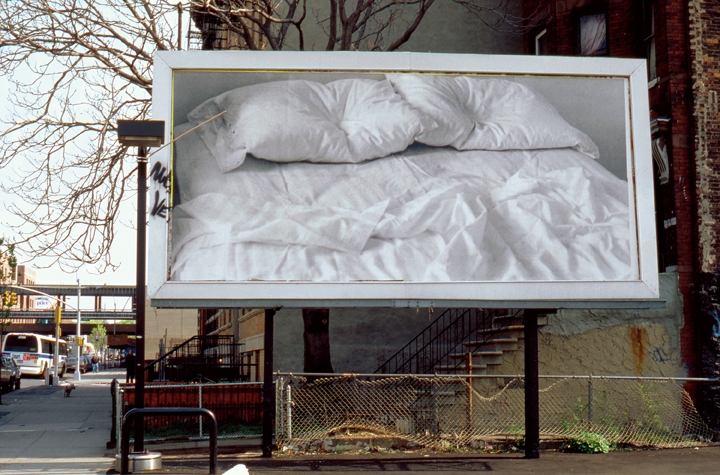 |
| Larry Wolf, Intimate Space (2019) |
Felix Gonzalez-Torres
 |
| Felix Gonzalez-Torres, Untitled (1991) Third Avenue and East 137th Street, Bronx, NY. |
"Untitled" (1991) is striking because it makes such an intimate domestic scene so public. ... The all-white image of recent intimacy is soft and inviting, but it takes on a darker shade once we realize that 1991 was the year that Gonzalez-Torres's partner, Ross Laycock, died of AIDS after a long illness. At least retrospectively, then, the piece functions as a memorial, both celebrating their loving relationship and commemorating it.
Yet this reading may tie the image too closely to autobiography, for the work also has a distinctly political edge. It is a protest and provocation that intervened in what was at the time a highly charged situation. The intimacy of the image and the publicity of its exhibition were particularly transgressive in the context of the hysterical reaction in the United States to the AIDS epidemic, which provoked fierce conservative attacks on homosexuality.
If the work is viewed as a memorial, it is illuminating to observe how it inverts, point by point, the form of medieval tomb sculpture. Those monuments, made of enduring materials like bronze or marble and sheltered in the sacred space of a church, show royal or aristocratic couples lying in effigy side by side, their heads resting on hard pillows. "Untitled" seems to evoke these tombs but exchanges their features for the ephemerality, profanity, and democracy of the commercial billboard. More over, the couple in Gonzalez-Torres's posters is indicated only negatively, not by statuary but by the impressions left behind on pillows.
Viewed now, in retrospect, the emptiness of the bed foretells the artist's own tragic death only five years later, in 1996.
from Photography Trace and Trauma - Margaret Iversen (2017)
Contextual Notes
I made the above photograph in 2019 as part of a self-portrait project, showing our bed after my husband and I had been reading in the morning. At the foot of the bed is a book of David Wojnarowicz's Rimbaud in New York photographs. Wojnarowicz made a mask from a photograph of Arthur Rimbaud, the French poet, and made portraits of himself and others wearing that mask in iconic New York locations.
I began reading Margaret Iversen's Photography Trace and Trauma this week in preparation for a reading group that starts next month (Exploring Death, Grief and Trauma, led by Kean O'Brien at Latitude). Iversen's description of Felix Gonzales-Torres' Untitled 1991 reminded me of the photo that I created three years ago. I did not consciously remember Gonzales-Torres' photograph when I created mine, though it's certainly possible I had seen it in the past. In keeping with Iversen's text, that image could well have left a trace in my unconscious and influenced the image I created.
It is fascinating that evidence of a prior presence can speak powerfully about its absence in the present.
No comments:
Post a Comment